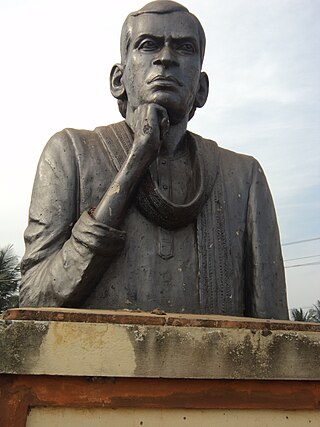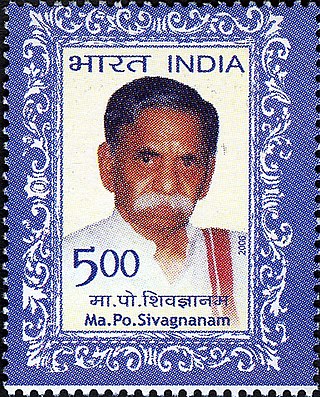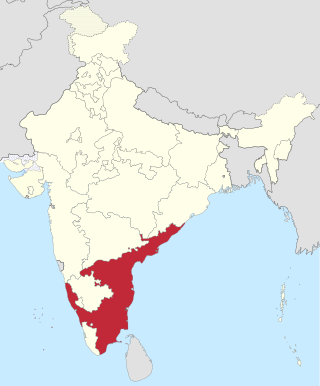Related Research Articles

Potti Sreeramulu, was an Indian freedom fighter and revolutionary. Sreeramulu is revered as Amarajeevi in the Andhra region for his self-sacrifice for the Andhra cause. He became famous for undertaking a hunger strike for 56 days in support of having separate state for Andhra Pradesh; he died in the process. His death sparked public rioting and Indian Prime Minister Jawaharlal Nehru declared the intent by the newly liberated nation to form Andhra State three days following the death of Sreeramulu. He contributed his life for the formation of a separate Telugu-speaking state from the dominant Tamil-speaking Madras presidency. His struggles led to the formation of separate Telugu-speaking state called "Andhra state".
The Justice Party, officially the South Indian Liberal Federation, was a political party in the Madras Presidency of British India. It was established on 20 November 1916 in Victoria Public Hall in Madras by Dr C. Natesa Mudaliar and co-founded by T. M. Nair, P. Theagaraya Chetty and Alamelu Mangai Thayarammal as a result of a series of non-Brahmin conferences and meetings in the presidency. Communal division between Brahmins and non-Brahmins began in the presidency during the late-19th and early-20th century, mainly due to caste prejudices and disproportionate Brahminical representation in government jobs. The Justice Party's foundation marked the culmination of several efforts to establish an organisation to represent the non-Brahmins in Madras and is seen as the start of the Dravidian Movement.

Andhra Bank was a medium-sized public sector bank (PSB) of India, with a network of 2885 branches, 4 extension counters, 38 satellite offices and 3798 automated teller machines (ATMs) as of 31 March 2019. During 2011–12, the bank entered the states of Tripura and Himachal Pradesh. It operated in 25 states and three union territories. It had its headquarters in Hyderabad, Telangana, India. Along with Corporation Bank, Andhra Bank was merged with Union Bank of India in April 2020.

Bhogaraju Pattabhi Sitaramayya was an Indian independence activist and political leader in the state of Andhra Pradesh. He was also the first governor of Madhya Pradesh. His books include Feathers and Stones, The History of Congress, and Gandhi and Gandhism.
Pattabhi is an Indian name.

Kasinadhuni Nageswararao, better known as Nageswara Rao Pantulu, was an Indian journalist, nationalist, politician, businessman, and a staunch supporter of Khaddar movement. He participated in the Indian independence movement and in the Indian National Congress party, including Mahatma Gandhi’s civil disobedience movement through salt satyagraha. He was conferred with the title Desabandhu by the people of Andhra Pradesh. He was a major financier of Congress activities in Andhra and Chennai and is also known for patenting Amrutanjan. He was conferred with the title Desoddhaaraka by the Andhra Mahasabha. In 1935, the Andhra University honoured him with Kalaprapoorna, an honorary doctorate of Literature.

Garimella Satyanarayana was a poet and freedom fighter of Andhra Pradesh, India. He influenced and mobilised the Andhra people against the British Raj with his patriotic songs and writings, for which he was jailed several times by the British administration.
The States Reorganisation Commission (SRC) constituted by the Central Government of India in December 1953 to recommend the reorganization of state boundaries. In September 1955, after two years of study, the Commission, comprising Justice Fazal Ali, K. M. Panikkar and H. N. Kunzru, submitted its report. The commission's recommendations were accepted with some modifications and implemented in the States Reorganisation Act in November, 1956. The act provided that India's state boundaries should be reorganized to form 14 states and 6 centrally administered territories. On December 10, 1948, the report of Dar Commission was published but the issue remained unsolved.
Noble College in Machilipatnam was founded by late Robert Turlington Noble, an English missionary, in 1843. Rev. Noble came to then Masulipatnam as a Christian Missionary in 1841 and stayed until his death. He and his friend late Mr. Sharkey opened a native English school on 21 November 1843 as Noble High School. That school became Noble College later on. This school was termed by the head of the Madras Government "The Cambridge of South India." It is one of the first four educational institutions opened in India by the British Government.

Mylai Ponnuswamy Sivagnanam, popularly known as Ma.Po.Si., was an Indian politician, freedom fighter, and the founder of the political party Tamil Arasu Kazhagam. He wrote more than 100 books.

The first legislative assembly Election to the Madras state based on universal adult suffrage was held in March 1952. This was the first election held in Madras state after the Indian Independence. This election was officially known as the 1951 Madras State Election, even though through delays, actual voting didn't take place until early 1952.

The second legislative assembly election for the Madras Presidency after the establishment of a bicameral legislature by the Government of India Act of 1935 was held in 1946. The election was held after 6 years of Governor's rule starting from 1939, when the Indian National Congress government of C. Rajagopalachari resigned protesting Indian involvement in World War II. This was the last election held in the presidency - after Indian independence in 1947, the presidency became the Madras state. The election was held simultaneously with that of the Legislative Council. The Congress swept the polls by winning 163 out of 215 seats. The years after this election saw factionalism in Madras Congress party with divisions across regional and communal lines. Competition among T. Prakasam, C. Rajagopalachari and K. Kamaraj resulted in the election of Prakasam as the Chief Minister initially. But he was later defeated by Omandur Ramaswamy Reddiar with Kamaraj's support. In turn, Reddiar himself was ousted to make way for P. S. Kumaraswamy Raja with the support of Kamaraj.
Sribagh Pact is an agreement made between the political leaders of Coastal Andhra and Rayalaseema regions during the separate Andhra in 16 November 1937. Historically, the Sribagh Agreement has been an important subject matter to the people of Rayalaseema region, as far as developmental issues due to the attitude of the then Andhra leaders.

Dukkipati Nageswara Rao was an Indian independence movement activist from Krishna District.

Samaikya Andhra Movement was a movement organized to keep the Indian state of Andhra Pradesh united, and to prevent the division of the state - separating the Telangana districts of the state into a separate Telangana state. The movement was supported by government employees, advocates in Coastal Andhra & Rayalaseema regions along with students from 14 universities, various occupational, caste & religious groups of Coastal Andhra & Rayalaseema regions. The last set of protests were triggered after the Congress Working Committee decision to divide the state came to an end after President of India gave nod to Telangana Bill which would make the latter to come into existence from 2 June 2014.

Madras State was a state of India during the mid-20th century. At the time of its formation in 1950, it included the whole of present-day Tamil Nadu, Coastal Andhra, Rayalaseema, the Malabar region of North and central Kerala, Bellary, South Canara and Kollegal. Coastal Andhra and Rayalaseema were separated to form Andhra State in 1953, while South Canara and Bellary districts along with the Kollegalam taluka of Coimbatore district were merged with Mysore State, and Malabar District with the State of Travancore-Cochin to form Kerala in 1956. Post State Reorganization in 1956, the remaining Madras State was renamed to Tamil Nadu on January 14, 1969.
Kaderbad Narasinga Rao,, popularly known as "Nandyal Gandhi", was a freedom fighter from Andhra Pradesh who fought for India's independence, philanthropist, social reformer, and political leader who worked tirelessly throughout his life to uplift disadvantaged people and eradicate untouchability.

Andhra Pradesh, retrospectively referred to as United Andhra Pradesh,Undivided Andhra Pradesh or Ummadi Andhra Pradesh, was a state in India formed by States Reorganisation Act, 1956 with Hyderabad as its capital and was reorganised by Andhra Pradesh Reorganisation Act, 2014. The state was made up of three distinct cultural regions of Telangana, Rayalaseema, and Coastal Andhra. Telangana was part of Hyderabad State formerly ruled by Nizam of Hyderabad, whereas Rayalaseema and Coastal Andhra were part of Andhra State which was formerly a part of Madras Presidency ruled by British India.
The Andhra Pradesh Decentralisation and Inclusive Development of All Regions Act, 2020 is an act of Andhra Pradesh Legislature aimed at the decentralisation of governance in the Indian state of Andhra Pradesh. The bill was proposed by the Government of Andhra Pradesh to establish three capitals at different places in the state namely Visakhapatnam, Amaravati, and Kurnool, which will serve as executive, legislative and judicial capitals respectively.
Yarlagadda Sivarama Prasad, also known as Challapalli Raja, was an Indian aristocrat, industrialist, politician, film producer, and film studio owner. He was the last hereditary zamindar of the Challapalli Samasthanam (estate). In politics, Sivarama Prasad was affiliated with the Indian National Congress. He served as the Minister of Health for Andhra Pradesh during the 1960s and was elected as an MLA from Krishna District.
References
- ↑ "Chronology of Events". Safhr.org. Retrieved 13 May 2013.
- ↑ "History and Culture - History-Post-Independence Era". APonline. Archived from the original on 20 December 2013. Retrieved 13 May 2013.
- ↑ Srivathsan, A. (18 August 2013). "The fight for Madras". The Hindu.